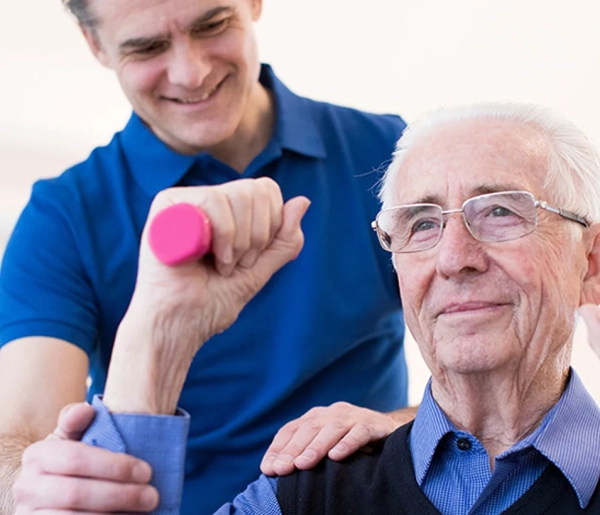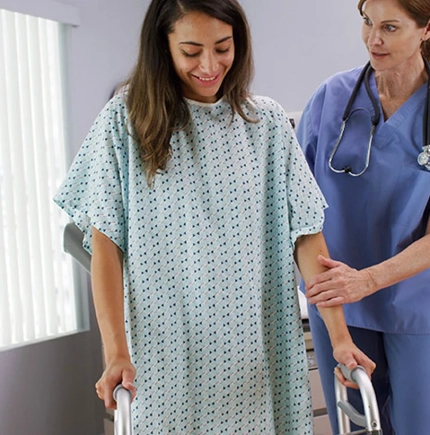Since the last two decades, explosive discoveries regarding the brain’s regenerative abilities have led to a vast array of neurological treatments. Previously, both acute and chronic neurological problems were strictly limited to impersonal and undisciplined treatment methods. Problems like spinal cord injury, brain injury, and multiple sclerosis (MS) had a limited scope of treatment.
Naturally, the chances of full or at least partial recovery were quite scarce. The failure of the brain and spinal cord coordination often leads to the worsening dysfunction of the peripheral nervous system. Even with mild strokes or paralysis, there were major complications and higher risk factors involved in the treatment.
As a part of neurologic rehabilitation, interdisciplinary clinical sciences have come together to find the correlation between the brain and functioning of body parts connected to the central nervous system under Neuro Rehabilitation.


- Mechanical Ventilation Program
- — Weaning Program
- Post Acute Rehabilitation
- — Musculoskeletal Rehabilitation
- — Post Surgeries Rehabilitation
- — Road Traffic Accident
- Pediatric Rehabilitation
- — Pulmonary Rehabilitation
- — Speech and Language
- — Neuromuscular Rehabilitation
- — Central Nervous System Anomalies
- — Long Term Care of Cardiac
- — Pediatric Transitional Care
- — Post Acute Care
- Long Term Care & Rehabilitation
- Outpatient Services
- Home Healthcare Services
Cambridge Medical & Rehabilitation Center (CMRC) is a leading provider of mechanical ventilation services in the United Arab Emirates and Saudi Arabia. Our facilities are committed to improving patient outcomes through a comprehensive and interdisciplinary approach to respiratory care.
Cambridge provides an interdisciplinary clinical approach for Neuro Rehabilitation which is customized for adults, adolescents, and children. The best rehabilitation services are not only our goal but our ultimate objective is to customize the care plan for each patient and make sure that the patient’s family and their members are integrated into the treatment plan.
At CMRC, you will experience comprehensive care that includes regular follow-ups, seamless care coordination, and community support—making your journey to recovery feel like #YourSecondHome.
Who are the Neurorehabilitation Experts?
Neurorehabilitation is a collective term representing the various neurological and rehabilitative treatments to rectify neurological dysfunctions. The diagnosis and correction of neurological disorders involve a wide range of clinical professions. This team of neurorehabilitation experts includes:
A neurologist and/or neurosurgeon. The professional associated with studying the central nervous system, the peripheral nervous system, as well as motor and sensory neurons.
An orthopedic surgeon, who works on the bones, joints, and issues related to range of motion that may be impaired due to neurological disease.
Physiatrist. This profession sheds light on the physical manifestations of neurological disorders and rehabilitation.
Internist. The doctor who specializes in internal medicine, organ treatment, and medication.
Specialty doctors. These are personalized on the basis of the patient’s specific symptoms, conditions, and requirements. A specialty doctor doesn’t work with people of all ages. This role is specified based upon the specific medical/surgical needs of the patient.
Rehabilitation specialists:
- Physical therapist. This person’s job is to treat and revive the motor functions of impaired body parts. Stroke rehabilitation and different types of neurological diseases such as Multiple Sclerosis actively employ the practice of physical therapy to ensure a full and healthy functionality.
- Occupational therapist. Use of everyday therapeutic activities to help a patient resume routine activities of dialing living (ADL’s).
- Speech and Language therapist. In diseases such acute stroke, patient suffer as aphasia and often lose their speech ability. The speech and language therapist uses oral and cognitive exercises to rehabilitate and improve speech and swallow function.
Social worker. This job supports the patient at time of discharge making certain that the patient and family have access to community support services.
Psychologist and psychiatrist. These are clinicians that focus on mental and behavioral health. This area includes the study of the psychological effects of brain and spinal cord injuries. They also analyze and manage patient behavior and the corresponding brain impairments, followed by prescribed medical advice as well as behavioral and cognitive therapies.
Recreational therapist. This job is similar to the occupational therapist. A recreational therapist’s part in neurorehabilitation is to help patients rebuild their confidence in life and work with people in different social settings through the use of recreational activities.
Case Manager. This position is essential to the overall management of the patient treatment and healing journey.
Audiologist. Attends to any audiological/hearing problems that arise due to disruption in the (auditory) nervous system.
Chaplain. Alongside psychological, physical, and social rehabilitation, spiritual-religious recovery is also a part of neurorehabilitation. This service is provided by a member of the clergy.
Vocational Counselor. This is a professional who guides patients to make careful decisions regarding career and skills development following rehabilitation.
Benefits of Neurorehabilitation
Coming to the benefits of neurorehabilitation, it has helped to solve many neuro-psycho-physical complications that baffled specialists for years. Now, however, neurorehabilitation has proved to be immensely helpful in treating a variety of neurological conditions. The current scope of a standard neuro rehabilitative program covers:
- Vascular disorders, such as ischemic and hemorrhagic strokes, TIA, and subdural hematoma
- Multiple sclerosis. It can include any type of MS
- Normal aging conditions
- Traumatic Brain injury and spinal cord injury. It helps to recover from the trauma caused by infections, accidents, etc.
- Neuromuscular and neurodevelopmental disorders. Includes Bell palsy, neural tumors, cervical spondylosis, carpal tunnel syndrome, peripheral neuropathy, muscular dystrophy, myasthenia gravis, and Guillain-Barré syndrome
- Functional disorders, including dizziness, seizure, neuralgia, migraine headache
- Neurological infections such as polio, meningitis, brain abscesses, encephalitis
- Neurodegenerative problems, including Parkinson’s disease, multiple sclerosis, Alzheimer’s disease, Huntington chorea
Concepts and Aims
The treatment of neurological disorders through neurorehabilitation involves the following concepts and aims:
- Neuro regeneration and repair
- Behavioral repair, adaptation, and rehabilitation
- Optimizing brain changes by targeting the affected areas of the brain.
- Invasive and noninvasive stimulation to reorganize functional neural pathways and increase the overall efficiency.
Sometimes, the symptoms, conditions, and eventually, the treatment of neurological dysfunctions may differ depending on the patient’s biology. For instance, people with MS (multiple sclerosis) do face the same basic problem. Their immune system attacks and destroys a tissue called myelin that insulates the nerve fibers in the body. For those living with MS, this means their sensory neurons are unable to carry data efficiently. However, immune-mediated multiple sclerosis has different effects on women than men. Women more frequently complain about:
- Bowel and bladder problems
- Severe hormonal disruption
- Cognitive changes and disturbances
- Dizziness, numbness, and vertigo
- Blurred vision and dismantled optic nerves
- Sexual health problems
- Digestive problems
- Difficulty in walking
- Muscle weakness, spasms, and stiffness
Based on the patient’s conditions, complications, and requirements, these are the most common neurorehabilitation techniques:
Constraint-Induced Motor Therapy
The CIMT is mainly used in cases of upper extremity paresis (weakness). In these cases where the paretic limb becomes immobile, but the sensory-motor nerve is intact. This paretic condition may result from MS, seizures, or paralysis. It is also sometimes found in stroke patients. In CIMT, the aim is to reconfigure and restore the weak limb movement using “learned nonuse.”
The stroke patient wears an immobilizing mitt on the unaffected hand, so the brain directs functioning commands to the paretic hand. The repetitive movements help in restoring the neural pathway. These therapy sessions are usually 3-6 hours long and last around two weeks. Post CIMT patients report notable functionality and mobility in their paretic limb.
However, there is a precondition: the patient must have some existing mobility and flexibility in the paretic limb. Prior to therapy, patients should be able to twist their wrist, move their fingers, and perhaps lift their hand. CIMT is considerably more economical and has better results than many other rehab options.
Weight Supported Treadmill Training
Aerobic training therapy, such as this weight supported therapy is useful in fighting the vulnerabilities that come with a sedentary lifestyle. While it may look odd to some people, weight supported treadmill walking can help improve overall bodily functioning. It is sometimes paired with CIMT and is linked to the neurological repair.
This consists of extensive treadmill walking at minimal speed levels to mobilize neurons in the lower part of the body. The patient dons a harness and has one supporting therapy technician at each leg. Another technician supports the trunk and abdomen area of the patient to maintain an upright stature.
Constraint-Induced Speech Therapy
Neurorehabilitation is one of the common treatments of aphasia. It is apparently limited to oral activities, but over time speech therapy has greater benefits on other neural activity, as well. The most prominent part of this therapy is the vicariation effect, where a patient improves speech in order to trigger nonverbal gestures.
The use of experience-based narrations triggers sensory pathways in other areas of the body, too. When the patient attempts to explain using hand or foot gestures, it reignites the jammed connection between the brain and limbs. The brain activity therefore stimulates connected neural networks, thereby supporting the therapy’s success.
CILT is also often paired with CIMT. The underlying logic is that experience-based CIMT supports improvements in chronic paralytic conditions, so the vocal stimulus may further help improve speech function. Concerning CILT, there is continuous research to support the efficacy of this therapy. Nonetheless it is a proven neurorehabilitative therapy to support chronic and acute aphasia conditions.
Prism Adaptation Training for Spatial Neglect
The inconsistent response and coordination that causes functional instability is common in stroke survivors. Visual therapy is an essential discourse to curb this disease. Visual and spatial coordination aims to correct exploratory spatial neglect of body-based locomotion.
The link between spatial errors and visual errors remains somewhat unclear to neuroscience, so this method is currently under scrutiny. Prism Adaptation Training (PAT) uses 20 diopters and 12.4 degrees with right-facing wedge lenses for ten short lessons.
Patients repeatedly point to targets while initially mistaking for the right. Gradually, hand-eye coordination grows, and spatial error decreases. After the session ended, many patients reported the immediate and positive effects of the treatment.